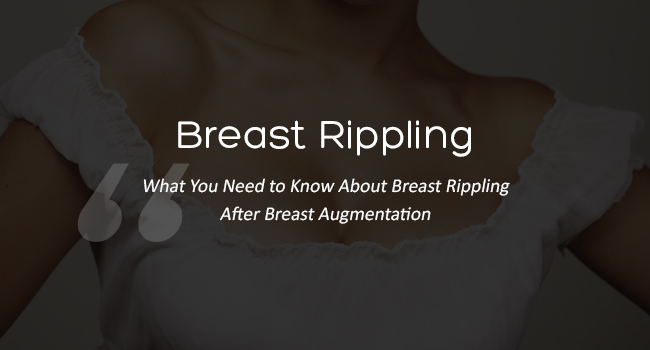Rippling of the breast surface is not uncommon after breast augmentation. If you hold a breast implant and squeeze it lightly, you will notice rippling around the edges. This rippling is due to the implant’s structure and is what gives your breasts a natural look. A more dense structure – such as a tennis ball – will not ripple but would also not create the aesthetically pleasing look of filled implants.
Most women are extremely happy with their augmentation, even though they can feel rippling upon palpitation, especially on the outside of their breast and in the cleavage area. Visible rippling is less common and should be discussed with your plastic surgeon.
The best way to minimize visible rippling is to select a board-certified plastic surgeon (such as Dr. Roudner) with extensive experience in breast augmentation. To reduce the visibility and palpability of rippling, your surgeon will help you select the type, style and profile of implant that best suits your body. Your surgeon will also determine the best location for the implants. Finally, your surgeon must have the technical skills needed to create the breast implant pockets in a way that reduces rippling and makes your breasts look natural.
How do I avoid rippling?
Each patient has different breasts and different goals. The ideal solution for breast augmentation in Miami will be based on your unique anatomy and your desired outcome. Your surgeon’s recommendations will depend on.
1. The amount of your breast tissue.
Every breast has a different shape and volume. Rippling will be more evident in women with a smaller amount of breast tissue. To minimize rippling, women with smaller amounts of breast tissue should choose smaller implants and have implants placed below the chest muscles.
2. Breast symmetry.
To create a symmetrical look in asymmetrical breasts, different size implants will be used in each breast. To avoid visible rippling in the larger implant, Dr. Roudner may advise smaller implants that are placed below the chest muscles.
3. Implant type.
Dr. Roudner will help you choose between saline and silicone implants. Some surgeons have found that saline is more inclined to ripple, although this issue can be mitigated by overfilling the saline implant. In general, gel implants tend to ripple less. Gel implants, however, require a larger incision and some additional follow-up care.
4. Implant size.
Larger implants are more likely to ripple than smaller implants. However, the visibility of the rippling is determined based on the placement of the implants and the amount of the patient’s breast tissue. Patients who have significant of breast tissue are at less risk for rippling, even with larger implants.
5. Implant profile.
There are many different profiles (shapes) of implants. The profile you select will determine the width and height of your implant, as well as where the fullness is located. Rippling is more likely to be evident in lower profile implants. Once again, Dr. Roudner will help you minimize rippling by recommending the profile that best suits your body.
6. Implant position.
Implants can be positioned above or below the chest muscles. If the implant is positioned below the chest wall (known as a “submuscular placement”), there is more breast tissue to cover the implant. In this case, rippling will be less noticeable.
7. Weight loss.
When you lose weight, you also lose breast tissue. This decreases the fat coverage on the breast tissue and makes rippling more obvious.
I have rippling. What can I do to fix it?
If you are unhappy with rippling after breast augmentation, discuss it with a board certified plastic surgeon (such as Dr. Roudner). There are several options to reduce rippling that include:
1. Fat grafting.
This is a great option for women who have thin breast tissue. By grafting fat over the implants, the rippling is less noticeable. Fat grafting may take a few sessions to correct the rippling.
2. Changing the location of the implants.
If the implants are under the skin (known as a “subglandular placement”) they can be repositioned under the chest muscle. Placement of implants below the muscle will increase tissue coverage of the implants and make rippling less noticeable. Creation of a “neo” pocket in a new submuscular position may help as well.
3. Reducing the size of your implant.
Rippling is less likely to occur in smaller implants. If rippling is bothersome, reducing the size of the implants might be the answer.
4. Changing the profile of the implant.
A higher profile implant may reduce rippling due to a higher fill volume of the implant.
5. Overfilling saline implants.
If you think of an implant as a water balloon, you know that a fuller balloon is less “sloshy” than an emptier balloon. Overfilling saline implants is like tightly filling the balloon and leaves less space for ripples.
6. Switching from saline to gel implants.
Gel implants tend to be denser and patients find them less prone to rippling. Gel implants are a safe and a good choice for women who are experiencing rippling with their saline implants.
7. The use of ADM
The use of ADM (acellular dermal matrix) such as strattise, or a surgical scaffold such as SERI can help increase the thickness of the tissues between the skin and implants and reduce visibility and palpability of the implants.
Dr. Roudner is highly experienced with minimizing and correcting rippling following breast augmentation. Please call our office to schedule a consultation.

What You Need to Know About Breast Rippling After Breast Augmentation

